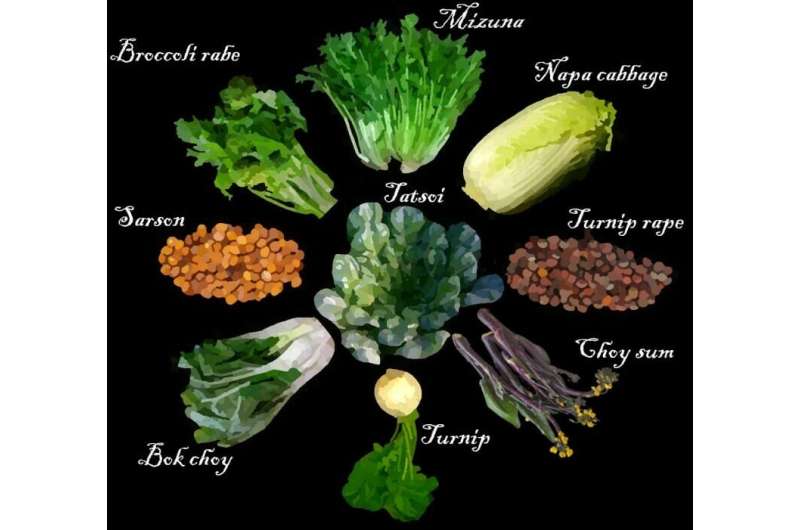First we tamed turnips, then we turned them into bok choy and other veggies

Humans likely domesticated turnips near the Hindu Kush mountains, near present day Afghanistan, 3,500 to 6,000 years ago before spreading them east and west and breeding them into related vegetables like bok choy and broccoli rabe.
This is according to new research representing the most complete look yet at how humans domesticated the ubiquitous species Brassica rapa. The findings untangle the complex web of domestication in this species, which can help researchers better understand evolution in general. They may also provide information for preserving important genetic resources as climate change and new pests threaten some crops.
University of Wisconsin–Madison Professor of Botany Eve Emshwiller and her former graduate student Alex McAlvay led the research, which was published April 30 in the journal Molecular Biology and Evolution.
By sequencing the DNA of more than 400 different varieties of Brassica rapa from around the world, they identified both the Hindu Kush as the likely center of domestication, and weeds from the Caucasus region as among the most likely wild relatives of the species' vegetable crops.
The true identities of these wild relatives—which have been hidden for years because of the tangled web of family relationships in the species—provide valuable information to evolutionary biologists and crop breeders alike.
"We might want this information in order to conserve those wild relatives, so they don't disappear in the course of habitats being lost," says Emshwiller. Wild plants can confer valuable traits when crossed with crops, which typically lose their hardiness during domestication.
"And domestication is a good way to study evolution in general," Emshwiller adds. "If we understand how crops evolved under human influence, that can help us extrapolate to how wild plants might evolve under different kinds of selection."
Much like how Labradors, Chihuahuas and pugs are all the same species of dog, Brassica rapa takes the form of dozens of unique-looking varieties, such as turnips or cooking greens, that are all very closely related. Today, these domesticated varieties are widespread in grocery stores, and weeds of the same species have also colonized most of the world.
Although it's long been known that dogs descended from wolves, the history of Brassica rapa is much murkier. Past research has variously located the original domestication event as taking place in Europe, West Asia, Central Asia or East Asia. And it's remained unclear if turnips or oilseeds were the first tamed varieties.
This confusion has stemmed from the ubiquity of Brassica rapa and its many weedy forms, which could be truly wild or merely escaped crops turned feral. While wild and feral forms look similar, their genetic histories are vastly different.
"In this work we used more than 400 samples (of the species), so we had a broader data set than had been used previously. And we also had more wild collections than had been used previously," says McAlvay, now an assistant curator at the New York Botanical Garden. "Having enough of those non-cultivated forms allowed us to distinguish between those feral or escaped weeds and the ones that are likely truly wild."
The genetic sequences of these varieties allowed McAlvay and his collaborators to reconstruct an evolutionary tree of the species. From this tree, they discovered that Central Asian turnips were the most genetically diverse crops. That in turn suggested that humans in the region likely initially selected for the fatter, starch-rich taproots that became turnips several thousand years ago, as agriculture took root around the world.
Ancient literary references to turnips in the region, and the apparent existence of the word for "turnip" in the ancestor of languages from the region, also supported the turnip as the original domesticated form.
Turnips then spread west to Europe and east to East Asia, where farmers later selected for larger leaves. These leafy versions became bok choy, napa cabbage and broccoli rabe, among other vegetables found today.
"That parallel selection for leafy forms is interesting and gives us an evolutionary system to compare how this leafiness trait can arise," says McAlvay. Other farmers selected other lineages for their oil-rich seeds.
From their hundreds of samples, the ones that appeared to be truly wild came mostly from the Caucasus region between Turkey and Russia. Two other wild relatives were isolated in Italy and Siberia, but they may have spread there from the Caucasus.
"We now know an important area to target for conservation of the wild relatives," McAlvay says.
The researchers also modeled the habitat suitability of wild Brassica rapa 6,000 years ago, around the time the species was domesticated. Past climates would have supported the species primarily in mountainous regions extending from East Asia to Western Europe, including the Caucasus and Hindu Kush regions, providing ample opportunity for humans to spread the species far and wide.
Going forward, the researchers want to include more weedy samples from the Hindu Kush region in particular. As the site of domestication, the region should continue to host wild versions of Brassica rapa.
In addition to the opportunities for conservation and better methods for studying domestication and evolution, McAlvay says there's a simple joy in understanding how that veggie on the grocery store shelf got to where it is.
"It's fun to know where your crops are from," he says.
More information: Alex C McAlvay et al, Brassica Rapa domestication: untangling wild and feral forms and convergence of crop morphotypes, Molecular Biology and Evolution (2021). DOI: 10.1093/molbev/msab108
Journal information: Molecular Biology and Evolution
Provided by University of Wisconsin-Madison




















